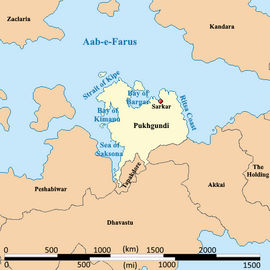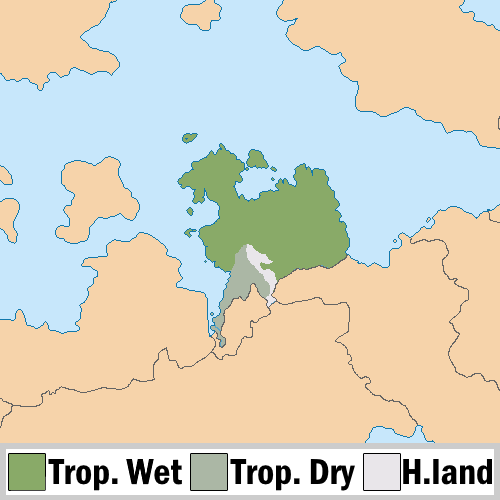Pukhgundi: Difference between revisions
m (→Society) Tag: 2017 source edit |
Tags: Mobile edit Mobile web edit Advanced mobile edit |
||
| Line 190: | Line 190: | ||
</gallery> | </gallery> | ||
==Economy== | ==Economy and infrastructure== | ||
= | <gallery mode="packed"> | ||
File:Wet rice paddy fields in Dibrugarh district, Assam, NE India.jpg | |||
File:Tea garden of Assam.jpg | |||
</gallery> | |||
The economy of Pukhgundi is characterized as an emerging market economy, heavily reliant on exports and foreign investment. It is classified as a lower-middle-income country, with a GDP per capita of $21,304. The economy is largely agrarian, with {{wp|basmati rice}}, {{wp|rapeseed}}, {{wp|mustard seed}}, {{wp|jute}}, {{wp|potato}}, {{wp|sweet potato}}, {{wp|banana}}, {{wp|papaya}}, {{wp|areca nut}}, {{wp|sugarcane}}, {{wp|turmeric}}, {{wp|Assam tea}}, and {{wp|Assam silk}} being major agricultural products. {{wp|Teak}} is the primary timber export. The fishing industry contributes to the economy, with {{wp|anchovies}}, {{wp|scad}}, {{wp|shrimp}}, and {{wp|Indian mackerel}} being the main catches. Mining, particularly of {{wp|tin}}, {{wp|bauxite}}, and {{wp|copper}}, also plays a role. | |||
===Standard of Living and Employment=== | |||
{{wp| | Pukhgundi's standard of living is relatively low compared to global averages. Poverty remains a significant challenge, with a large portion of the population engaged in subsistence agriculture or informal employment. While there has been some improvement in recent years, income inequality remains high. The unemployment rate is officially reported at around 6%, but underemployment is widespread, especially in rural areas. | ||
===Key Sectors=== | |||
* Agriculture: This sector employs the majority of the workforce and contributes to around 25% of GDP. The primary crops are rice, jute, potatoes, tea, and silk. The government has invested in irrigation projects and agricultural research to improve productivity. | |||
* Manufacturing: While still limited, the manufacturing sector is growing, focusing on import substitution of consumer goods and basic materials. There is also some production of textiles and garments for export. | |||
* Telecommunications: This sector is experiencing rapid growth, driven by increasing mobile phone penetration and competition between state-owned and private providers. Internet access is also expanding, though it remains limited in rural areas. | |||
{{wp|Assam tea}} | * Mining: The mining industry is relatively small but contributes significantly to export earnings. Tin, bauxite, and copper are the main minerals extracted. | ||
* Tourism: Pukhgundi has significant potential for tourism due to its natural beauty and cultural heritage. However, the tourism sector is still underdeveloped, with limited infrastructure and marketing efforts. | |||
===Foreign Investment and Involvement=== | |||
{{wp|Assam silk}} | Foreign investment, primarily from [[Burgundie]], plays a crucial role in Pukhgundi's economy. [[Burgundie|Burgoignesc]] firms have significant stakes in various sectors, including agriculture, mining, manufacturing, and telecommunications. This foreign investment has brought in capital and technology, but has also raised concerns about economic dependency and potential exploitation. | ||
===Trade and Exports=== | |||
Pukhgundi's main exports include agricultural products (rice, jute, tea, silk), minerals (tin, bauxite, copper), and seafood (anchovies, scad, shrimp). The country's primary trading partners are [[Burgundie]], [[Middle seas region]] nations, and some [[Levantia|Levantine]] countries. The government has implemented policies to promote exports and diversify trade partners. | |||
{{wp|Teak}} | |||
=== | |||
=== | |||
==== | |||
===Infrastructure=== | ===Infrastructure=== | ||
Revision as of 09:35, 30 June 2024
This article is a work-in-progress because it is incomplete and pending further input from an author. Note: The contents of this article are not considered canonical and may be inaccurate. Please comment on this article's talk page to share your input, comments and questions. |
Republic of Pukhgundi | |
|---|---|
|
Flag | |
 Location of Pukhgundi | |
| Capital | Sarkar |
| Largest largest city | Tarigar |
| Official languages | Pukhti, Burgoignesc |
| Ethnic groups | Primarily Pukhti Gorkhas |
| Religion | Primarily Hindu |
| Demonym(s) | Pukhgundti |
| Government | Republic |
• President | Nandakishor Mitra |
| Establishment | |
• Independence | 1811 |
| Area | |
• Total | 387,669.42 km2 (149,680.00 sq mi) |
| Population | |
• Estimate | 42,600,400 |
• Density | 109.888/km2 (284.6/sq mi) |
| GDP (nominal) | estimate |
• Total | $907,558,921,600 |
• Per capita | $21,304 |
| Currency | Common Middle Sea Florin (CMS ƒ) |
| Driving side | right side |
Pukhgundi, officially the Republic of Pukhgundi, is a minor-power sovereign country central in western Audonia. It is bound by the Aab-e-Farus in the north, Tapakdore in the southwest, Dhavastu in the south, Akkai in the southeast, and the Sea of Saksona in the west. It is a constitutional republic with universal suffrage is praised for holding consistently open and fair elections in the Region.
It is a member of the League of Nations, the International Red Cross and Red Crescent Movement, and many other international organizations. It is a emerging market, market economy focused on exports, under the watchful eye of Burgundie whose companies have a massive stake in the country's economic activity. It is an active member in the Middle seas region's economic activity. Many scholars have criticized its economic governance and politics, arguing that it is merely a client of the Burgoignesc thalattocracy's economic and cultural might.
The people of Pukhgundi are predominantly culturally Pukhti Gorkha, speak Pukhti , and most practice Hinduism.
Geography
Climate

History
Prehistory
Arunid Empire
Oduniyyad Caliphate
Pukhgundi colony
Tea, silk, teak plantations, textiles
Modern-day period
First Great War
Politics and government
Society
Economy and infrastructure
The economy of Pukhgundi is characterized as an emerging market economy, heavily reliant on exports and foreign investment. It is classified as a lower-middle-income country, with a GDP per capita of $21,304. The economy is largely agrarian, with basmati rice, rapeseed, mustard seed, jute, potato, sweet potato, banana, papaya, areca nut, sugarcane, turmeric, Assam tea, and Assam silk being major agricultural products. Teak is the primary timber export. The fishing industry contributes to the economy, with anchovies, scad, shrimp, and Indian mackerel being the main catches. Mining, particularly of tin, bauxite, and copper, also plays a role.
Standard of Living and Employment
Pukhgundi's standard of living is relatively low compared to global averages. Poverty remains a significant challenge, with a large portion of the population engaged in subsistence agriculture or informal employment. While there has been some improvement in recent years, income inequality remains high. The unemployment rate is officially reported at around 6%, but underemployment is widespread, especially in rural areas.
Key Sectors
* Agriculture: This sector employs the majority of the workforce and contributes to around 25% of GDP. The primary crops are rice, jute, potatoes, tea, and silk. The government has invested in irrigation projects and agricultural research to improve productivity. * Manufacturing: While still limited, the manufacturing sector is growing, focusing on import substitution of consumer goods and basic materials. There is also some production of textiles and garments for export. * Telecommunications: This sector is experiencing rapid growth, driven by increasing mobile phone penetration and competition between state-owned and private providers. Internet access is also expanding, though it remains limited in rural areas. * Mining: The mining industry is relatively small but contributes significantly to export earnings. Tin, bauxite, and copper are the main minerals extracted. * Tourism: Pukhgundi has significant potential for tourism due to its natural beauty and cultural heritage. However, the tourism sector is still underdeveloped, with limited infrastructure and marketing efforts.
Foreign Investment and Involvement
Foreign investment, primarily from Burgundie, plays a crucial role in Pukhgundi's economy. Burgoignesc firms have significant stakes in various sectors, including agriculture, mining, manufacturing, and telecommunications. This foreign investment has brought in capital and technology, but has also raised concerns about economic dependency and potential exploitation.
Trade and Exports
Pukhgundi's main exports include agricultural products (rice, jute, tea, silk), minerals (tin, bauxite, copper), and seafood (anchovies, scad, shrimp). The country's primary trading partners are Burgundie, Middle seas region nations, and some Levantine countries. The government has implemented policies to promote exports and diversify trade partners.
Infrastructure
Maritime
Rail
Pukhgundi uses Standard gauge, 1,435 mm (4 ft 8+1⁄2 in) as most of its rail infrastructure has been under the auspices of Burgundie and its sphere of influence in the Middle seas region, who all use that rail gauge.
Roads

Louage
A louage is a minibus shared taxi in many parts of Daria that were colonized by Burgundie. In Burgoignesc, the name means "rental." Departing only when filled with passengers not at specific times, they can be hired at stations. Louage ply set routes, and fares are set by the government. In contrast to other share taxis in Audonia, louage are sparsely decorated. Louages use a color-coding system to show customers what type of transport they provide and the destination of the vehicle. Louages with red lettering travel from one state to another, blue travel from city to city within a state, and yellow serves rural locales. Fares are purchased from ticket agents who walk throughout the louage stations or stands. Typical vehicles include: the MILCAR Jornalero, the TerreRaubeuer Valliant 130, and the CTC M237-07.
Air
Energy and electricity
Agrinergie
Main article: Agrivoltaics













